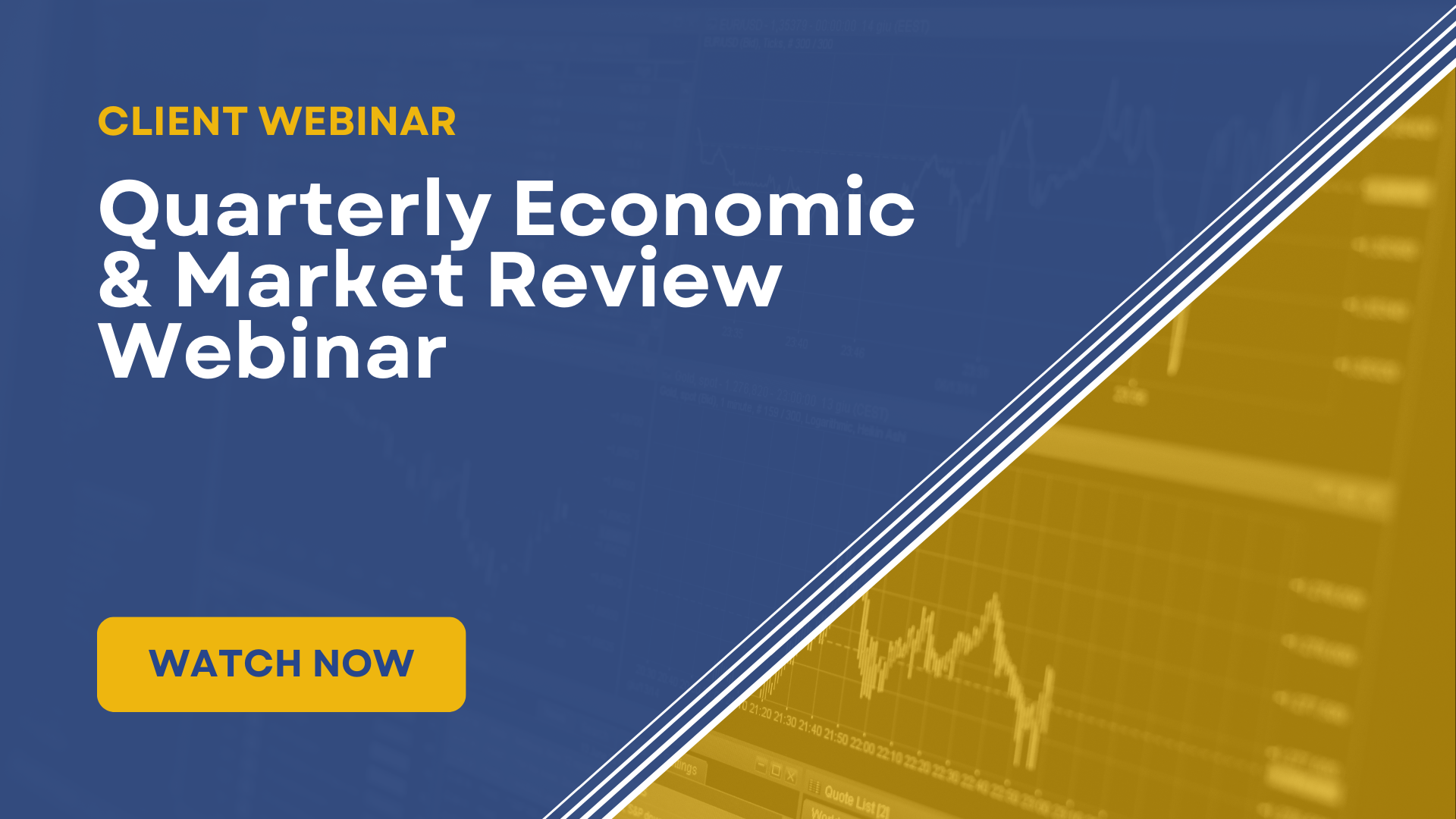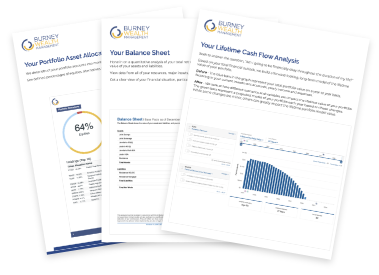Economic & Market Review: Q3 2023 [Webinar Summary]

Presenters: Lowell Pratt, CFA, Andy Pratt, CFA, CAIA, and Adam Newman, CFA, CFP®, RICP®
Here is the webinar recording from October 18th, 2023. You can browse topics discussed and main takeaways using the sections and time stamps below:
- Introduction and Current Events (00:00)
- Market Overview and Key Themes (01:36)
- Concentration of Returns and Market Trends (04:21)
- Market Discrepancies and Dominant Players (05:29)
- Market Concentration and Recovery Potential (06:36)
- Interest Rates and Bond Market Dynamics (07:44)
- Yield Curve Interpretations and Implications (10:02)
- Resilience of Stock Markets Amid Rising Rates (10:56)
- Economic Observations (12:25)
- Economic Resiliency vs. Predictions (15:03)
- Goldman Sachs Webinar: Forward-Looking Expectations (19:00)
- Goldman Sachs Predictions and Market Valuation (19:55)
- Optimistic Market View (20:56)
- Large Caps vs Small Caps Dynamics (21:49)
- Stock Selection Importance (24:38)
- Distinguishing Between Models (26:31)
- Standard Model vs. Recovery Model Performance (28:24)
- Understanding 'Beta' in Stocks (31:26)
- Influence of AI in Investment Strategy (32:37)
- Perspective on Transformative Technology (35:34)
- Sector Insights: Defense Stocks and Geopolitical Events (36:44)
Introduction and Current Events (00:00)
- Thank you everyone for joining us for our quarterly webinar, addressing the recent geopolitical tensions and their influence on investor sentiment.
- The ongoing global events have spiked oil prices, yet the primary concern for investors is still inflation, earnings, and the resilience of the economy.
- Domestically, the uncertainty of appointing a new speaker in the house brings about challenges, but the situation needs resolution for proper government functioning.
- Highlighting the concerning performance of long-term treasuries, with three consecutive years of negative returns. However, stocks seem to be bouncing back, and there's hope for the future.
Market Overview and Key Themes (01:36)
%20Q2%20Economic%20and%20Market%20Update%20(1).pptx%20(17).jpg?width=800&height=600&name=(09.30.23)%20Q2%20Economic%20and%20Market%20Update%20(1).pptx%20(17).jpg)
- A general review of major asset classes' performance last quarter, noting similarities between domestic and international equities.
- Real Estate Investment Trusts (REITs) took a hit, primarily due to their relationship with fluctuating interest rates.
- Emphasis on the bond market's three consecutive years of negative returns, particularly in long-term maturities.
- Despite these setbacks, equity markets remain resilient, suggesting the challenges of market-timing based on geopolitical or economic news.
- Highlight on the outperformance of international markets compared to domestic ones in 2022, reiterating the benefits of diversified investments across various geographies.
Concentration of Returns and Market Trends (04:21)
%20Q2%20Economic%20and%20Market%20Update%20(1).pptx%20(18).jpg?width=800&height=600&name=(09.30.23)%20Q2%20Economic%20and%20Market%20Update%20(1).pptx%20(18).jpg)
- Discussion of the concentration of returns in the current year, emphasizing the dominance of a few companies in driving market gains.
- Presentation of historical data from the S&P 500, showcasing the year-wise performance and the contribution of the top 10 holdings to the overall index.
- For 2023, nearly 97% of the S&P 500's 12% gain is attributed to its top 10 holdings, marking a significant deviation from previous years and emphasizing the market's current state of concentration.
Market Discrepancies and Dominant Players (05:29)
%20Q2%20Economic%20and%20Market%20Update%20(1).pptx%20(2).jpg?width=800&height=600&name=(09.30.23)%20Q2%20Economic%20and%20Market%20Update%20(1).pptx%20(2).jpg)
- Elaboration on the concentration of returns over the past few decades, particularly within the S&P 500.
- Focus on the current year, 2023, where an overwhelming majority (97%) of the index's growth is driven by only the top 10 companies.
- Highlighting that such a high level of concentration is anomalous when compared to historical data.
- Noting the typical dominance of larger companies, but the current situation showcases an extreme, with the concentration often ranging from 30% to 50% in prior years.
- The importance of understanding these dynamics for investors, as a handful of companies significantly sway the market, potentially posing risks or opportunities.
Market Concentration and Recovery Potential (06:36)
- Adam delves deeper into the extreme concentration of returns in the S&P 500 and its implications.
- By comparing the S&P 500 returns to its equal-weighted version, a disparity is evident, mainly driven by a few dominant players.
- Such concentration patterns historically revert to the mean over time.
- Emphasis on the underperformance of these few companies in 2022 and the subsequent expectation for broader market recovery. The diversification benefits for investors outside of these major companies are projected to be pronounced.
- This unusual market behavior is underscored for its significant historical context.
Interest Rates and Bond Market Dynamics (07:44)
%20Q2%20Economic%20and%20Market%20Update%20(1).pptx%20(3).jpg?width=800&height=600&name=(09.30.23)%20Q2%20Economic%20and%20Market%20Update%20(1).pptx%20(3).jpg)
- Discussion pivots to the bond market, especially in the context of shifting interest rates.
- Detailed examination of returns for bonds of different maturities since 2020, spotlighting the stark negative returns for intermediate and long-term treasuries.
- Comparison of the severe downturn in long-term treasuries to stock market bear scenarios. These bonds faced significant losses due to rising interest rates.
- Emphasis on the differentiation among bonds, with advice against long-term bond investments in the current climate.
- Promotion of short-term bond investments, based on current risk-reward dynamics.
Yield Curve Interpretations and Implications (10:02)
- Introduction to the yield curve and its frequent mentions in news, including the phenomenon of the "inverted yield curve."
- Graphical representation described, detailing yield rates over various time horizons. The current curve showcases higher yields for short-term treasuries compared to their long-term counterparts.
- Recommendation geared towards treasuries of six months or less, as yields drop off significantly for longer durations.
- Observation that despite rising interest rates and the shifting yield curve, stock markets remain resilient.
- The closing note emphasizes caution in bond investments and underscores the value of maintaining a focus on short-term fixed income. The stock market's potential reaction to these interest rate dynamics remains a topic to closely monitor in the upcoming periods.
Resilience of Stock Markets Amid Rising Rates (10:56)
%20Q2%20Economic%20and%20Market%20Update%20(1).pptx%20(4).jpg?width=800&height=600&name=(09.30.23)%20Q2%20Economic%20and%20Market%20Update%20(1).pptx%20(4).jpg)
- Adam notes the surprising endurance of stock markets despite the turbulence in the bond markets and shifting interest rates.
- There's acknowledgment of the stock market's ability to weather both domestic and geopolitical events without major disruptions.
- He highlights the growing realization that the economy remains robust, leading to increasing interest rates.
- The change in dynamics, where even short-term treasuries now offer reasonable returns after a long stagnant period, is spotlighted.
- Closing thoughts stress the importance of portfolio diversification and staying vigilant. While the stock market has shown resilience so far, the interplay of various economic factors in the coming months could influence market behaviors, reinforcing the need for strategic and cautious investment decisions.
Economic Observations (12:25)
%20Q2%20Economic%20and%20Market%20Update%20(1).pptx%20(5).jpg?width=800&height=600&name=(09.30.23)%20Q2%20Economic%20and%20Market%20Update%20(1).pptx%20(5).jpg)
- Little economic change from the last quarter.
- Stable labor market with sub 4% unemployment and slowed wage growth, beneficial in terms of inflation.
- The labor market remains strong, and inflation rates have stabilized just under 4%.
- A question arises about the durability of the 3-4% inflation rate and the journey back to the 2% target.
- Fed chairman Powell has deferred expectations on achieving the 2% target.
- Uncertainty remains about the impact of inflation and the labor market on U.S. company profits.
- Last quarter, 90% of S&P 500 companies beat earnings estimates; this quarter, 85% have done so thus far.
- Observing how businesses adapt and show resilience against economic challenges.
Economic Resiliency vs. Predictions (15:03)
%20Q2%20Economic%20and%20Market%20Update%20(1).pptx%20(6).jpg?width=800&height=600&name=(09.30.23)%20Q2%20Economic%20and%20Market%20Update%20(1).pptx%20(6).jpg)
- Reference to a one-year-old headline predicting a 100% chance of an impending recession, which didn't materialize.
- A caution against trusting predictions with high certainty, given the unpredictable nature of financial markets.
- Mention of the "September Effect": historically, stocks tend to perform poorly in September.
- In past years, negative Septembers have been followed by strong fourth quarters.
- Discussion on reasons behind the September dip and speculations for Q4 performance.
Goldman Sachs Webinar: Forward-Looking Expectations (19:00)
%20Q2%20Economic%20and%20Market%20Update%20(1).pptx%20(8).jpg?width=800&height=600&name=(09.30.23)%20Q2%20Economic%20and%20Market%20Update%20(1).pptx%20(8).jpg)
- Goldman Sachs webinar highlights an optimistic view based on a bottom-up analysis.
- Using individual company performance data, Goldman predicts strong returns for the S&P 500 in the next 12 months.
- Despite recent stock market declines, price targets have risen by approximately 5%, hinting at undervaluation.
- Goldman anticipates a 23% chance of a market increase of 5% or more in the upcoming month, surpassing options predictions.
Goldman Sachs Predictions and Market Valuation (19:55)
- Goldman's historical predictions have largely been accurate, with their last year's projection almost aligning with the actual 20% stock increase.
- While current expectations aren't as high as previously, they still predict better than average returns for the next year.
- Despite the recent stock market downturn, price targets have been adjusted upwards across the board, hinting at potential undervaluation.
- This upward adjustment suggests that the market sees value and potential in companies, despite short-term declines.
- Goldman Sachs also indicates a significant likelihood of a notable market uptick in the near term, emphasizing potential short-term investment opportunities.
Optimistic Market View (20:56)
%20Q2%20Economic%20and%20Market%20Update%20(1).pptx%20(9).jpg?width=800&height=600&name=(09.30.23)%20Q2%20Economic%20and%20Market%20Update%20(1).pptx%20(9).jpg)
- Market predicts a 12% upside potential.
- An emphasis on looking beyond negative headlines.
- Unchanged investment strategy favoring small-cap stocks.
- “Wave chart" indicating bullish long-term trend for small caps.
Large Caps vs Small Caps Dynamics (21:49)
%20Q2%20Economic%20and%20Market%20Update%20(1).pptx%20(10).jpg?width=800&height=600&name=(09.30.23)%20Q2%20Economic%20and%20Market%20Update%20(1).pptx%20(10).jpg)
- Large caps showed strength but didn't affect the long-term trend for small caps.
- A shift from pro-value to pro-growth momentum.
- The top 10 stocks significantly influenced S&P 500 returns.
- By fall, returns balanced out between large and small caps.
Stock Selection Importance (24:38)
%20Q2%20Economic%20and%20Market%20Update%20(1).pptx%20(12).jpg?width=800&height=600&name=(09.30.23)%20Q2%20Economic%20and%20Market%20Update%20(1).pptx%20(12).jpg)
- Stock selection emphasized, second to size and style decisions.
- Two primary models:
Distinguishing Between Models (26:31)
%20Q2%20Economic%20and%20Market%20Update%20(1).pptx%20(13).jpg?width=800&height=600&name=(09.30.23)%20Q2%20Economic%20and%20Market%20Update%20(1).pptx%20(13).jpg)
- The standard model targets stocks with quality, profitability, and attractive valuations during standard market phases.
- Recovery model looks at factors post bear markets.
- Differentiation between the two models provides a balanced strategy.
Standard Model vs. Recovery Model Performance (28:24)
%20Q2%20Economic%20and%20Market%20Update%20(1).pptx%20(14).jpg?width=800&height=600&name=(09.30.23)%20Q2%20Economic%20and%20Market%20Update%20(1).pptx%20(14).jpg)
%20Q2%20Economic%20and%20Market%20Update%20(1).pptx%20(16).jpg?width=960&height=720&name=(09.30.23)%20Q2%20Economic%20and%20Market%20Update%20(1).pptx%20(16).jpg)
- The standard model performs consistently but tends to underperform in strong return months; termed as "inverted performance".
- Recovery model experiences the opposite, outperforming in strong months but being more vulnerable in down months.
- The combination of both models provides a balanced and more consistent investing approach.
Understanding 'Beta' in Stocks (31:26)
- Lowell Pratt explains the concept of 'beta', which measures stock volatility.
- A beta of 1 implies the stock moves with the market, while higher beta suggests greater volatility. High beta stocks are suitable for the recovery score model.
Influence of AI in Investment Strategy (32:37)
- AI is a topical point of interest but has been in development for decades by major tech companies.
- AI's influence on stock prices can be disruptive. Companies using AI effectively might perform better, while others might not.
- Andy Pratt warns about investing solely based on AI trends and recommends a cautious approach.
Perspective on Transformative Technology (35:34)
- Lowell Pratt views AI as transformative technology, similar to the advent of the internet.
- The impact of AI will have winners and losers, with stock selection focusing on companies that can adapt and thrive with new technology.
Sector Insights: Defense Stocks and Geopolitical Events (36:44)
- Defense stocks tend to have consistent contracts and profitability, similar to utilities.
- Global unrest suggests defense stocks are important for portfolios, but predicting short-term sector moves remains challenging.
- Goldman's perspective includes a bullish view on biotech, retail, and defensive stocks, while being less bullish on oil companies.
The Burney Company is an SEC-registered investment adviser. Burney Wealth Management is a division of the Burney Company. Registration with the SEC or any state securities authority does not imply that Burney Company or any of its principals or employees possesses a particular level of skill or training in the investment advisory business or any other business. Burney Company does not provide legal, tax, or accounting advice, but offers it through third parties. Before making any financial decisions, clients should consult their legal and/or tax advisors.




